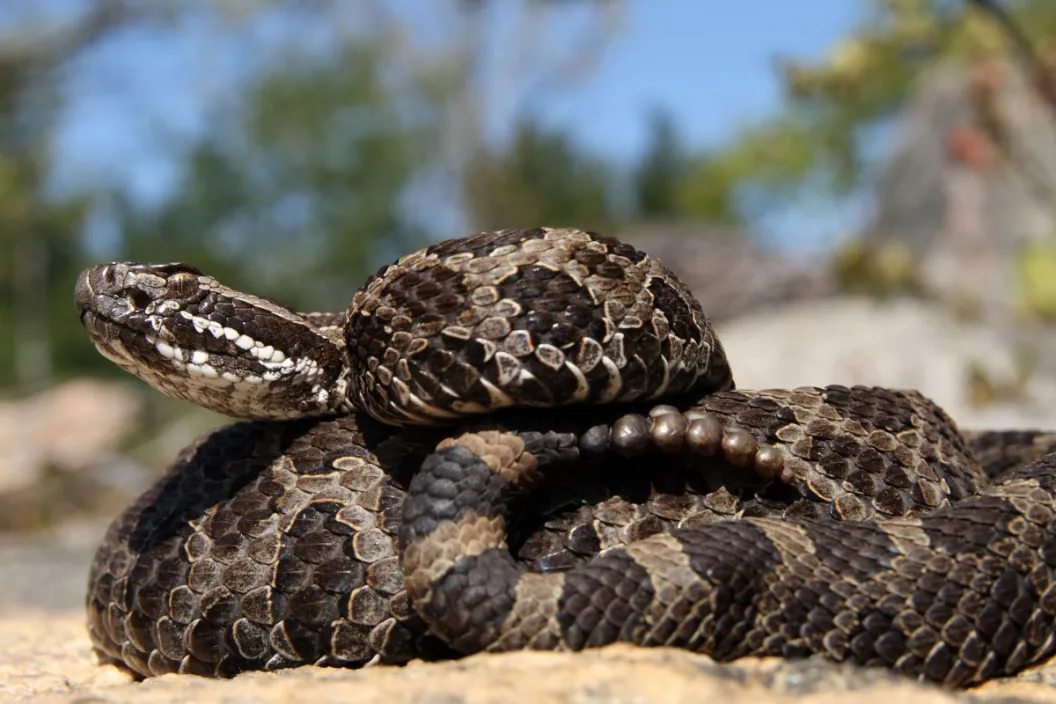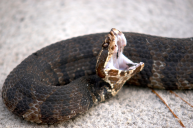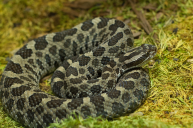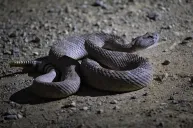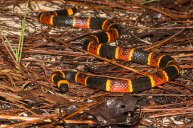Both the Upper and Lower Peninsulas of Michigan are known for the plethora of wildlife that reside there. The Great Lakes State's many wooded areas, plus countless lakes and rivers make an ideal habitat for deer, elk, bears... and snakes.
That's right: A staggering 18 species of snake call Michigan home, with only one venomous snake in the state: the eastern Massasauga rattlesnake. The state is free from cottonmouths and water moccasins. In fact, many of the native snakes are less than three feet long.
General Background on Michigan Snakes
Popular culture tends to vilify snakes, however. That Michigan's snakes are somehow dangerous is inappropriate assumption, especially considering Michigan's mostly non-venomous population. In fact, chances are you won't ever come in contact with a snake in Michigan at all, according to the Michigan Department of Natural Resources (DNR), which says that the state's snakes will avoid humans and will not "chase, attack, or otherwise, approach humans." Even the formidable rattlesnake will probably try to hide or slither away as fast as possible.
Having said that, if you see a snake, do not approach it. The DNR advises that leaving snakes alone helps to protect them so that they can continue their important role in the local ecology. Five of Michigan's 18 species are listed as either endangered, threatened, or species of special concern, including the gray rat snake, Kirtland's snake, copper-bellied water snake, eastern fox snake, and the aforementioned eastern Massasauga rattlesnake. The DNR underlines the importance of not only leaving wild snakes be, but also ensuring you purchase a proper fishing license and know state laws in place to protect snakes and their habitats.
In hopes of clearing up the bad publicity surrounding Michigan's snakes, we've compiled a list of native species, including how to identify them, where they can be found, and what the snakes eat.
1. Eastern Garter Snake
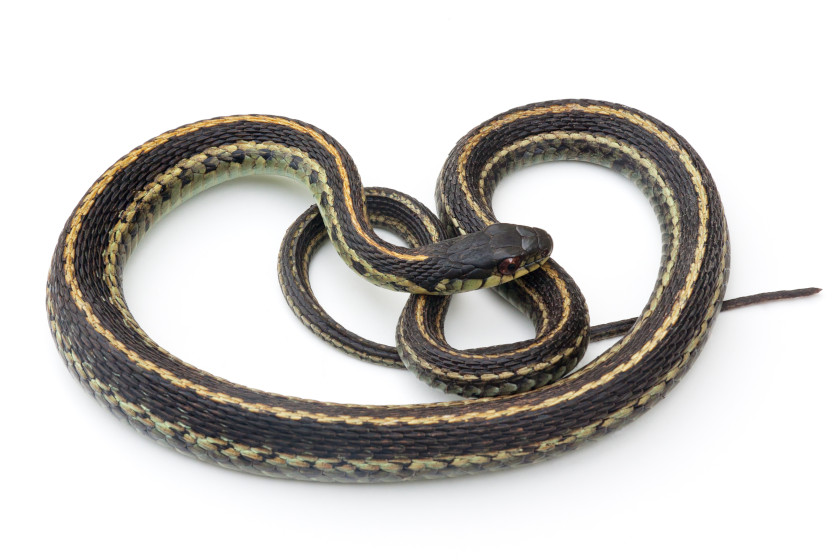
Epantha, Getty Images
The eastern garter is one of the most common snakes in Michigan. It only grows about two to four feet long and features three stripes running the length of its body. The stripes can vary in color from orange to brown or even bluish in color but are usually yellow.
You're most likely to find eastern garter snakes hanging around grassy areas, but they can be found just about anywhere. They mainly eat smaller animals like frogs, mice, and earthworms, though they might also enjoy the occasional fish or bird if they can catch one.
2. Butler's Garter Snake
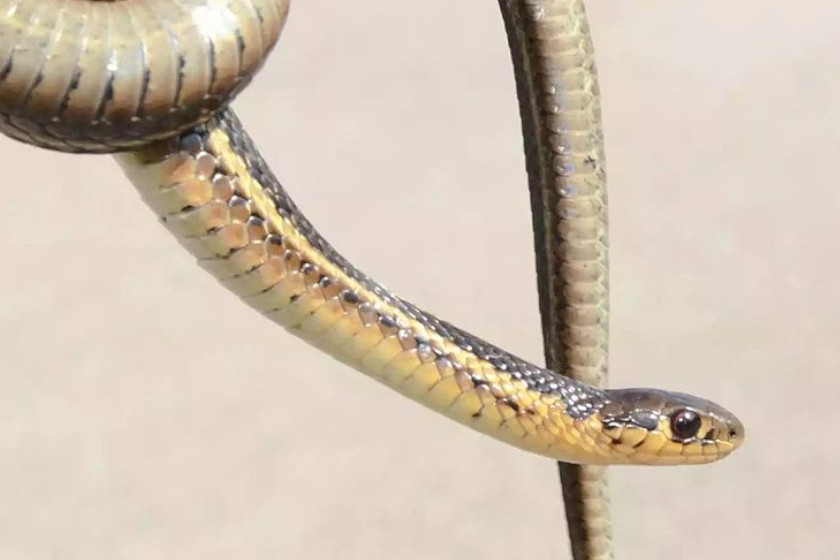
Wikimedia Commons, Mark Nenadov
Butler's garter snake is very similar to the eastern garter, and it can be easy to confuse them. Much like the eastern garter, Butler's has a row of stripes along its length that can vary in color from orange to brown, though they're most commonly yellow. However, they are not as easily sighted and they're much smaller: The Butler's species only grows to a little over two feet in comparison to the eastern's up to four feet.
They can be found in grassy and marshy areas, and they're usually more afraid of you than you are of them. Because of their small size, they mostly eat worms.
3. Northern Ribbon Snake
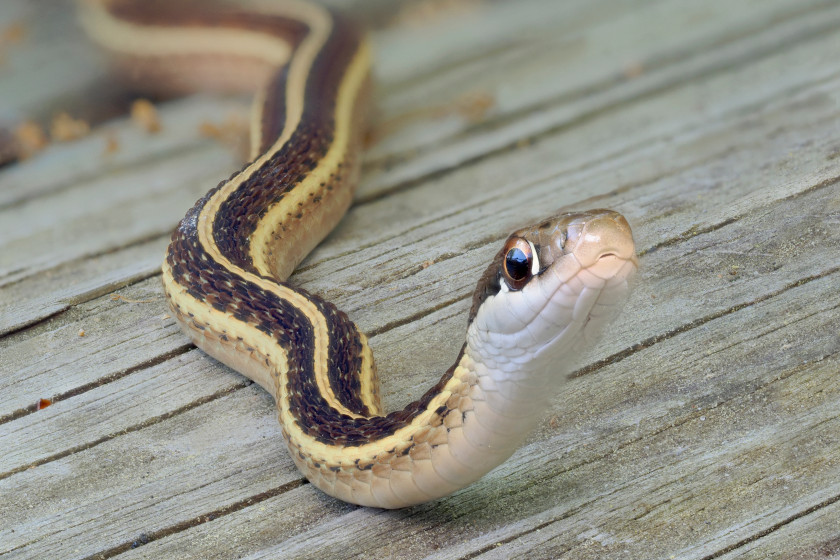
Getty Images, sdbower
The northern ribbon snake is also often confused with Michigan's two garter snakes because of its similar striping pattern. You can tell this non-venomous species apart by the white patch of scales under the black-colored mouth. Sometimes the stripes take on this white color, too, but most northern ribbons have yellow stripes.
Much like the Butler's garter, this snake doesn't get very big. Most are only a foot and a half to two feet in length. They hang out in marshes where they feed on frogs, fish, worms, and insects. They can also be found in grassy fields throughout the spring and summer months. This is another highly skittish species that will likely flee at first sight of you.
4. Northern Ring-Necked Snake
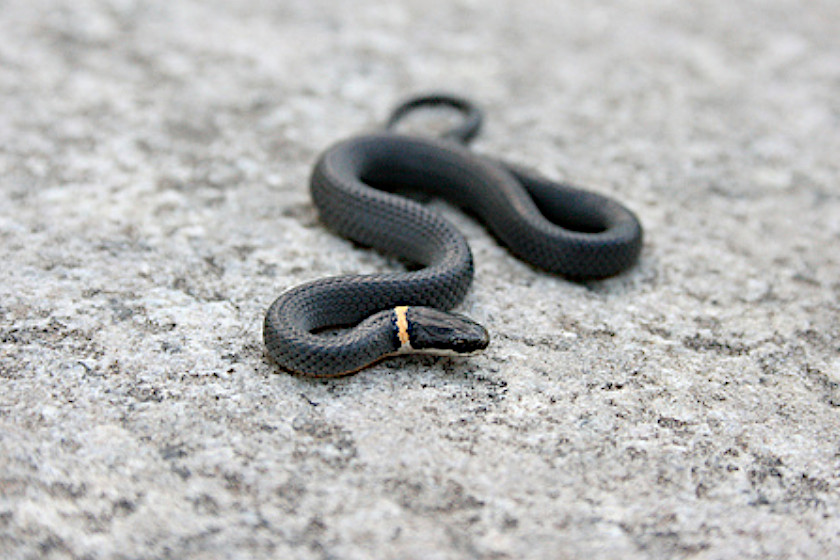
Wikimedia Commons, Cody Hough
The northern ring-necked snake is possibly one of the most elusive snakes on this list—even the DNR has difficulty monitoring this one. That's because this snake is nocturnal and often described as secretive. The ring-necked snake doesn't get very big, only about 10 to 20 inches in length, helping it all but disappear into the grass and leaf litter.
The good news is, it's easy to identify and not one you're likely to mix up with another species. The snake is usually solid black or blue/blue-gray in color. The northern ring neck's signature mark is a brightly colored yellow or orange belly with a colored ring around its neck. Ring necks to hang out in wooded areas and are non-venomous.
5. Northern Red-Bellied Snake
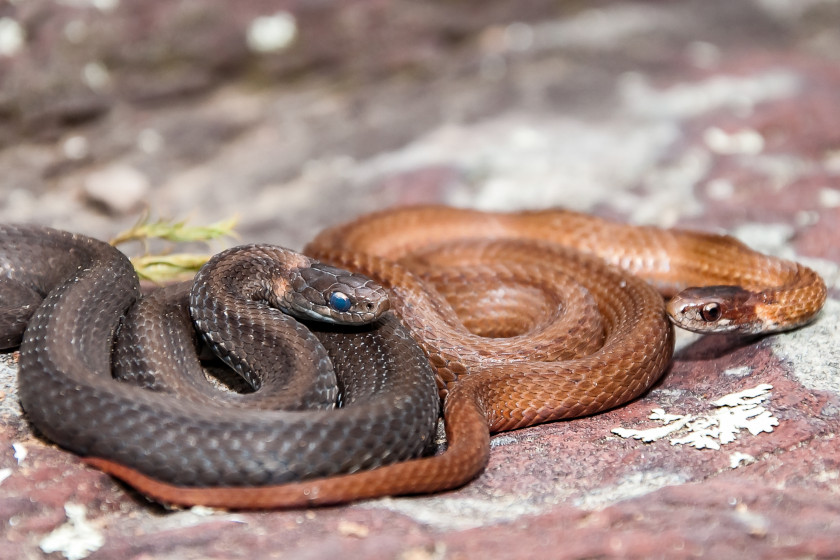
Getty Images, JasonOndreicka
The northern red-bellied snake is another that proves extremely elusive due to its small size. This snake tops out at about 16 inches at its largest. The markings on this species are rather mundane. They're usually just brown, red-brown, or gray in color, which helps them blend in perfectly with leaves or dirt, hiding them from predators. The belly is a different story, though you're not likely to see it: It's usually pink to bright red in color. Some specimens might have a subtle striped pattern on their backs as well.
Northern red-bellied snakes live in a variety of wilderness areas including forests, marshes, and grassy fields. This non-venomous snake species eats worms or very small slugs.
6. Brown Snake
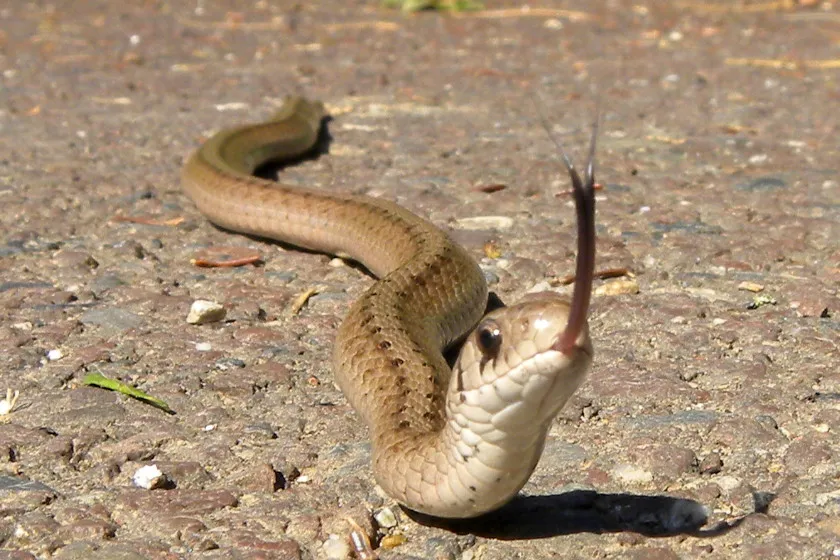
Wikimedia Commons, Tie Guy II
The brown snake follows the Michiganian pattern of small stature. The brown snake is another microserpent, only reaching around 15 inches long at the largest. In many ways, this one closely resembles the various garter snake species but is much lighter in color, usually appearing brown or tan. Some may have darker stripes and splotches running down their body.
Like many of the other small species of snake in Michigan, brown snakes mostly eat small insects and worms. They're non-venomous and like to hang out in a variety of areas including grasslands and marshes to wooded areas. You'll need to keep your eyes peeled to spot one of these guys. They're very shy and one of the toughest snakes to observe in the wild.
7. Kirtland's Snake
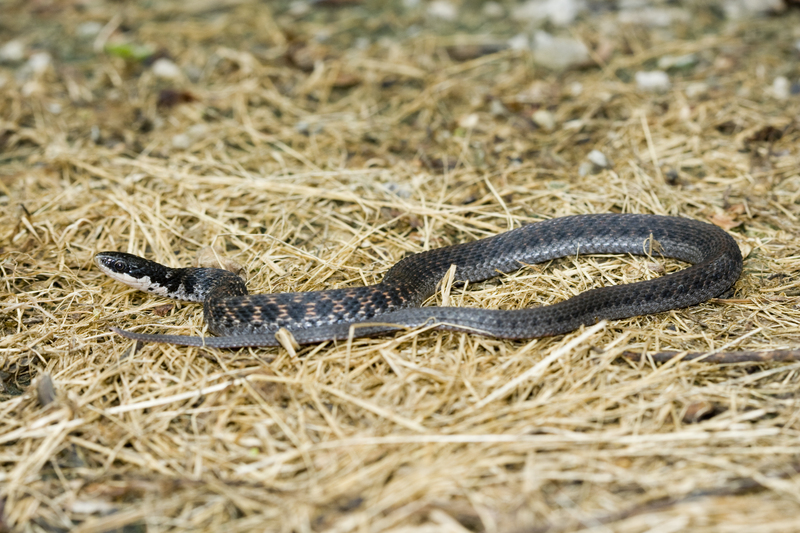
Wikimedia Commons, Don Becker
Kirtland's snake is hard to find in Michigan because it is, unfortunately, listed as endangered. This small snake only grows to about two feet in length and is characterized by a red, gray, or brown body speckled with darker blotches.
This snake has a small range across Indiana, Illinois, Ohio, some parts of northern Kentucky, and a very small range in Pennsylvania. Unfortunately, it's threatened or endangered in almost all those states. This species is non-venomous and mainly likes to hang out in areas where there is water.
8. Queen Snake
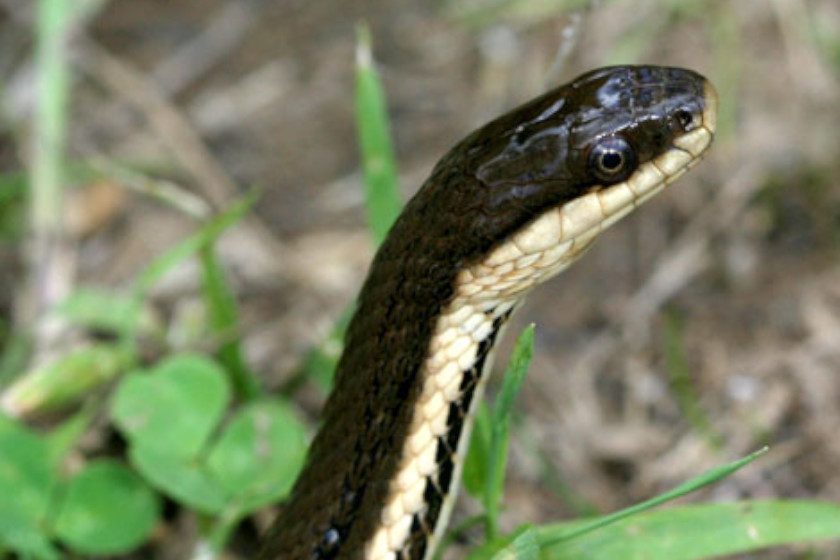
Wikimedia Commons, Patrick Coin
This regal quen snake is characterized by a mostly dark gray or brown coloration with a yellow stripe on both sides of their bodies from head to tail. This non-venomous species generally doesn't get very big; larger adults generally get about 36 inches long at the largest.
The Michigan DNR has the queen snake listed as a species of special concern. Unfortunately, it's lost many of its areas of natural habitat, namely small streams with rocky bottoms. Queen snakes may eat minnows, tadpoles, and other small water creatures, but their favorite food is crayfish.
9. Smooth Green Snake
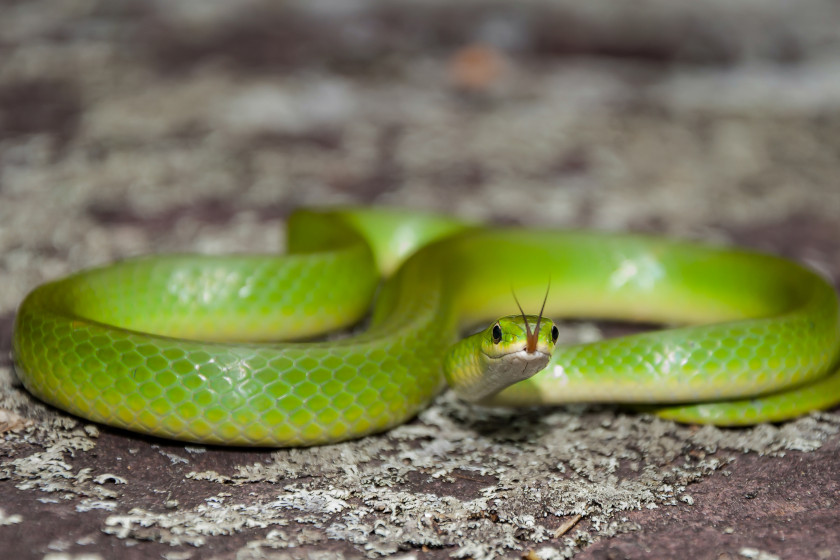
Getty Images, JasonOndreicka
This is the easiest snake species to identify in Michigan due to its distinctive coloration—usually bright green or pale yellow. The smooth green snake is not one that can be confused with any others in Michigan! It only gets about two feet long at the largest.
This non-venomous species likes a variety of habitats including grassy areas, forests, marshes, and lakes but is getting harder to find in Michigan; their numbers are being closely watched by wildlife authorities. Smooth green snakes are a threat only to the insects that make up most of their diet.
10. Western Fox Snake
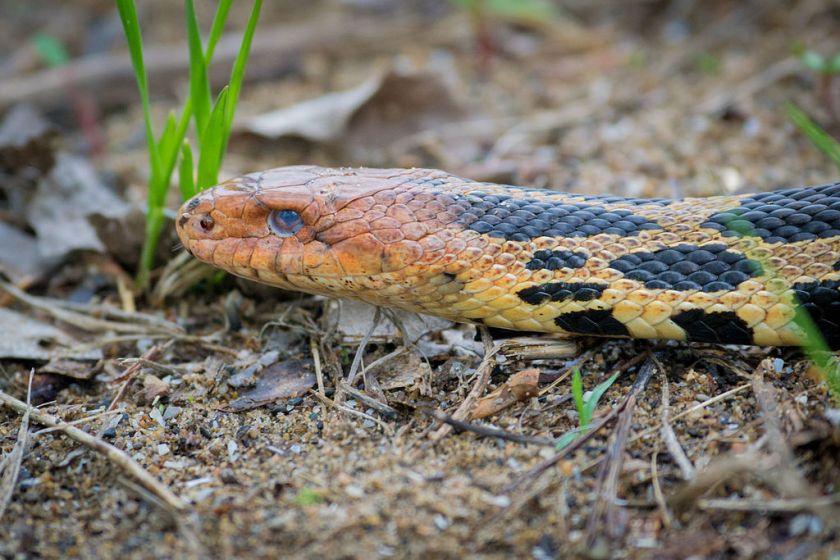
Wikimedia Commons, Andrew C
The western fox snake lives in the Upper Peninsula and grows anywhere from three to five feet in length. It's characterized by a lighter-color body speckled with splotches that can vary in color from yellow to dark brown. Unfortunately, this non-venomous species is often unjustly killed because many people think it looks dangerous. Fox snakes are often confused with rattlesnakes because they sometimes shake their tail in a similar manner.
The snake gets its name from a distinct musky odor it may give off when cornered, like a fox. The western fox snake is one of special concern to Michigan authorities as it faces habitat destruction of the woodlands and prairie lands it calls home. This snake is a helpful species that likes to feed on mice and other rodents that can be a nuisance to humans. This snake's name is sometimes used interchangeably with the next snake on the list, the eastern fox snake.
11. Eastern Fox Snake
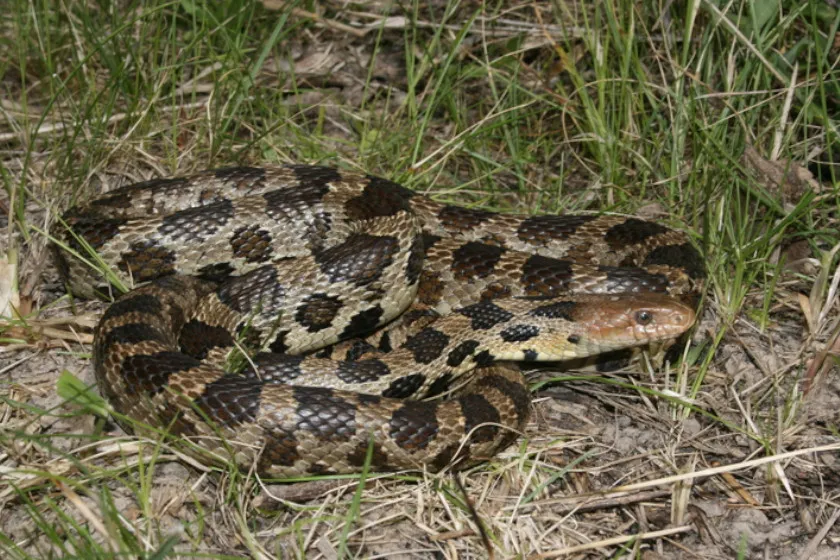
Wikimedia Commons: Don F. Becker
This species is nearly identical to the western fox species. That's also one of the reasons for conflicting reports on the number of snakes that call Michigan home (although the DNR says this species is isolated to the southeastern part of the state). The eastern fox snake is usually characterized by dark splotches on a lighter body and grows between three and five feet long.
The eastern fox snake faces some threats, mostly because they are popular as pets and are often taken from their native habitats of marshes and wetlands. In addition, like the western version, it shares the habit of coiling up and sometimes shaking its tail, which may lead to them being killed after someone mistakes them for a rattlesnake. It's too bad they have a bad rap because this non-venomous species helps with controlling rodent populations.
12. Eastern Milk Snake
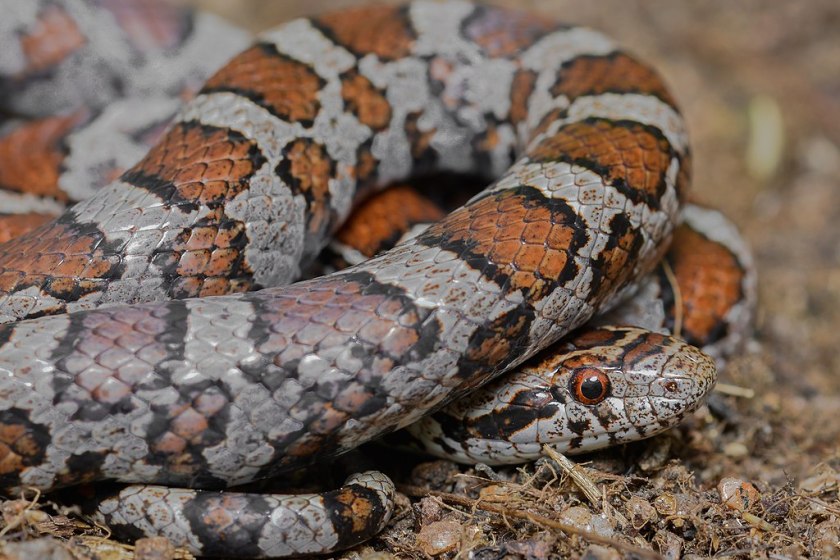
Wikimedia Commons, Will Brown
Another harmless snake that can get up to four feet long, the eastern milk snake is a particularly beautiful species. This one is usually characterized by a gray or tan body with brown splotches over the length of its body. They usually have a belly that is pale in coloration.
You aren't likely to run into one of these while out and about on your outdoor adventures, though. These non-venomous predators mostly hunt at night for the insects that make up their diet.
13. Eastern Hog-Nosed Snake
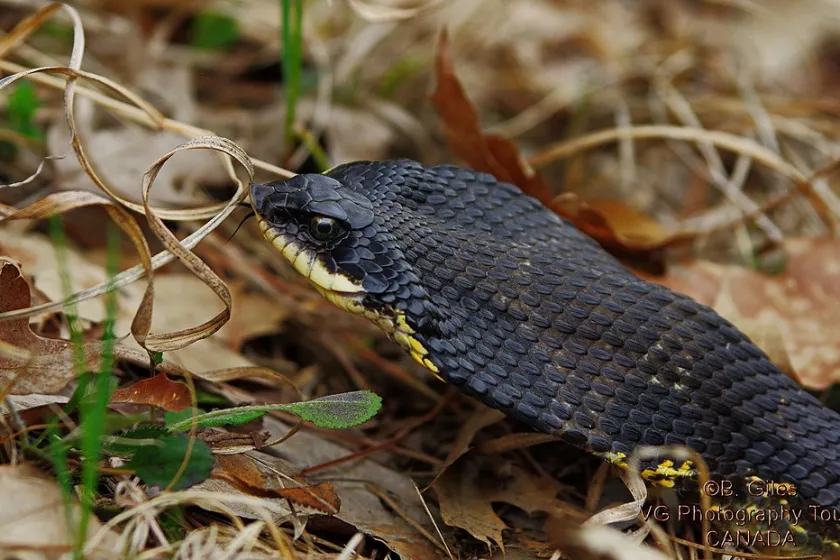
Wikimedia Commons, Barry Giles
The eastern hog-nosed snake is one of the more interesting snake species in the state of Michigan. The color varies wildly, sometimes being solid in color, other times marked with irregular spots or patterns. They grow to about 40 inches in length. This one is often confused with venomous species because of the way it flattens out its head and neck when it is cornered, almost giving the appearance of a cobra's hood. The other interesting behavior the hog-nosed snake exhibits when threatened is rolling onto its back and playing dead.
Non-venomous, this snake is only dangerous if you're a frog, toad, or salamander, which are their preferred meals. Unfortunately, the unique coloring and behaviors often lead to this species being mistaken as dangerous and result in them being needlessly killed.
14. Blue Racer
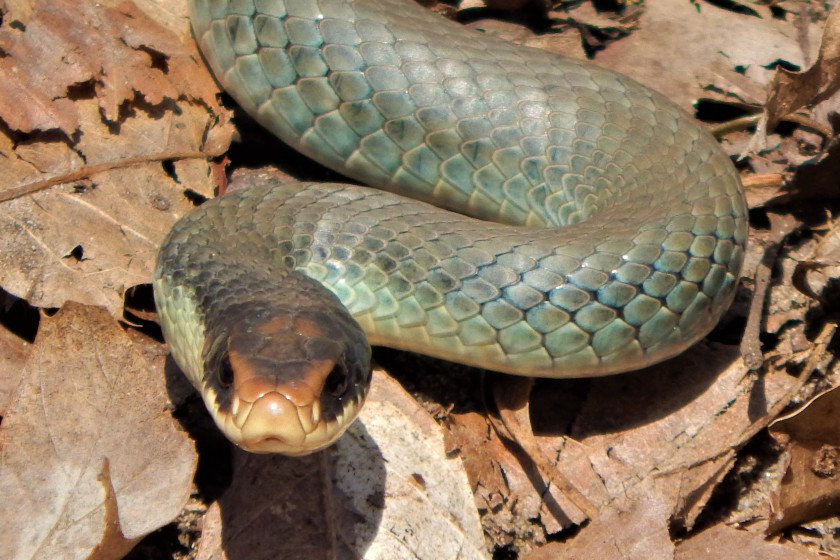
Getty Images, ErikAgar
The blue racer is another contender for the title of the most beautiful snake species in Michigan. This species is usually dark blue to bluish-gray with a lighter-colored belly. It often grows quite large, from four to six feet in length. Getting a close look is a real challenge, as blue racers don't particularly like humans. In fact, if you see one, you'll immediately know where the "racer" part of the name comes from; they tend to quickly zip out of the area at first sight of a human.
This species can be helpful to humans by feeding on rodents, but it also will cannibalize smaller snake species. You'll generally find this snake hanging out in drier areas.
15. Black (or Gray) Rat Snake
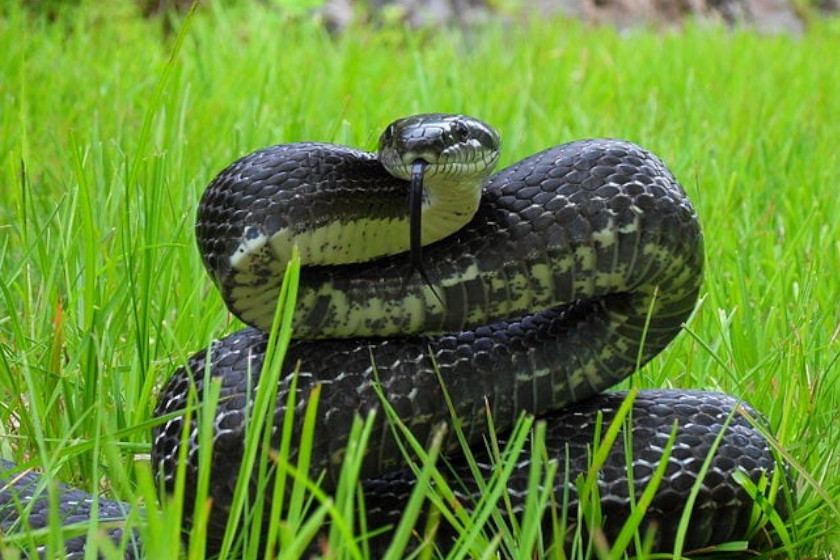
Wikimedia Commons, Stephen Lody Photography
Easily the largest snake species in Michigan, the black rat snake can reach lengths of eight feet. These snakes are easy to spot because of their large size and black or dark brown coloration. Younger snakes might exhibit slight patterning. Adults are sometimes mistaken for blue racers, but a racer will likely run from you immediately. Rat snakes are a little bolder in the presence of humans.
This is a constrictor species that sometimes coils up and shakes its tail when cornered. But these snakes are non-venomous and kill their prey by constricting it like a python or boa. This species is another that is helpful to humans because it preys on pests like mice and rats. Cut this snake a break if you come across it, especially since the DNR is becoming concerned with how these snakes are becoming less and less common. The DNR considers the black rat snake and the gray rat snakes as pretty much one and the same species.
16. Northern Water Snake
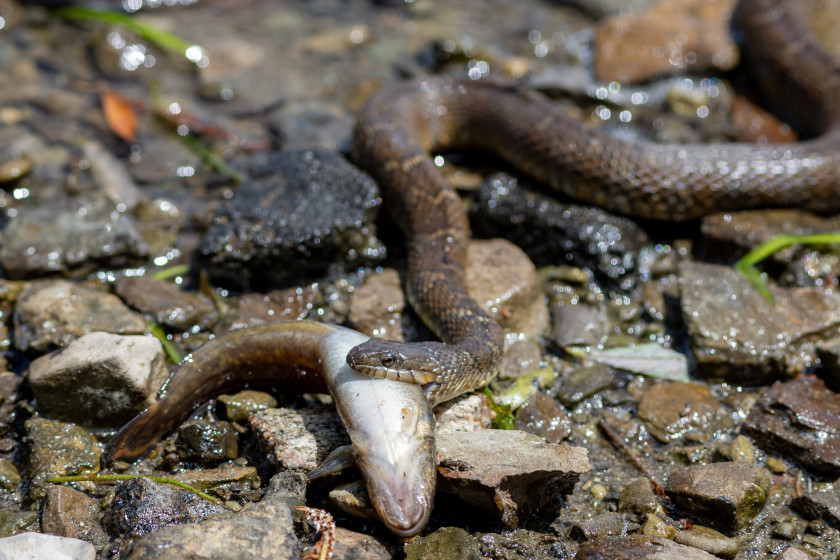
Getty Images, Colin Temple
The northern water snake is quite possibly the culprit responsible for the mistaken reports of cottonmouths or water moccasins in the state. In truth, these are non-venomous and grow from two to four feet in length. Water snakes are usually dark in color with splotches that are usually rectangular in shape. They also have a "half-moon" shape on their bellies.
As the name suggests, they are talented swimmers and are commonly found in rivers and streams and occasionally basking in the sun on the branches of riverside trees. They typically eat minnows, frogs, and other amphibians. This species gets killed a lot simply because it can get quite defensive when cornered.
17. Copper-Bellied Water Snake
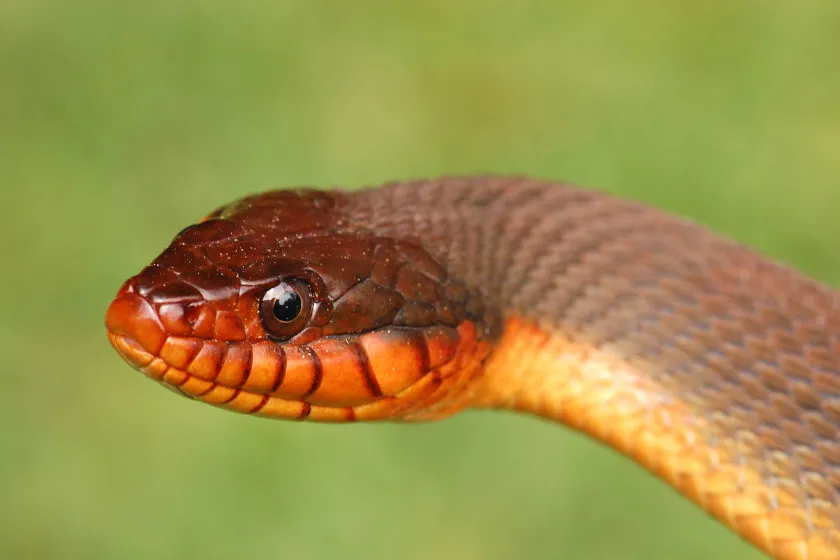
Getty Images, the4js
Copper-bellied water snakes are true to their name and are often found in water-logged areas. This snake can grow up to five feet long and is usually either solid black or gray in color. Though they sometimes have a pattern, it's usually quite light in coloration.
This snake is similar to the northern water snake though harder to find, thanks to its endangered status. The easiest way to tell this apart from similar-looking snakes is the belly. A copper-bellied water snake usually has a distinctive bright orange belly with no markings. This non-venomous species likes to eat frogs, small fish, and salamanders.
18. Eastern Massasauga Rattlesnake
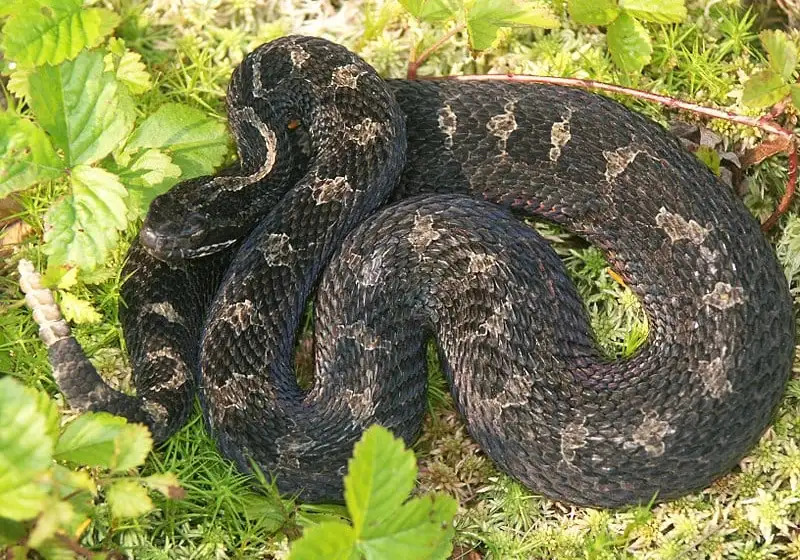
Wikimedia Commons, USFWSmidwes
Michigan's only venomous snake, the easter Massasauga rattlesnake, is listed as a threatened species. Though it's found in other, nearby states, Michigan is the stronghold for these snakes and its population here is important for the future of the species. This snake can be identified by its gray or grayish-brown appearance with spots on the top and an unpatterned belly. They tend to be confused with the eastern milk snake, eastern fox snake, eastern hog nose snake, and northern water snake. However, unlike these other snakes, the eastern Massasauga rattlesnake has live births instead of laying eggs. This snake is typically no more than two-and-a-half feet long, but will most often be spotted all coiled up. This snake is primarily found in wetlands around the Lower Peninsula and occasionally in open, sunny areas as well.
When they feel threatened, this rattlesnake tends to freeze in an attempt to blend with its surroundings. It's important to note that a rattlesnake will not attack unless it feels its life is in danger. Even if you hear a rattle (or see a tail flick), you can back away slowly and leave the snake alone. It will not chase you.
Though attacks on humans are rare, the bites are not commonly fatal due to the short fangs which can only release a small amount of venom. It's still important to seek medical attention if bitten, however, especially for young children or people in poor health.
READ MORE: Rattlesnake Vaccine for Dogs: Everything You Need to Know, According to a Vet
